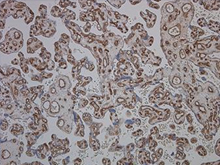s
CD34: Monomeric Single-Pass Type I Membrane Protein

CD34 is a monomeric single-pass type I membrane protein. CD34 is selectively expressed on hematopoietic stem cells, endothelial cells, leukemic blast cells, and normal hematopoietic progenitors. The antibodies against CD34 are grouped into three classes based on the resistance of the cognate epitope to enzymatic cleavage by neuraminidase, chymopapain, and a glycoprotease from Pasteurella haemolytica.
Epitopes recognized by class I antibodies are sensitive to all the three proteases. Class II (QBEND/10) are resistant to neuroaminidase, while class III (clone 581) are resistant to neuraminidase, chymopapain and glycoprotease.
CD34 Antibodies
| Description | Target | Format | Clone | Applications | Citations | Code |
|---|
Recent Publications with our Antibodies
Mouse anti Human Class II antibody clone QBEND/10
-
Cunnea P et al (2010) Gene expression analysis of the microvascular compartment in multiple sclerosis using laser microdissected blood vessels.
Acta Neuropathol 119(5):601-15 -
Zimmermann G et al (2009) Epithelial human chorionic gonadotropin is expressed and produced in human secretory endometrium during the normal menstrual cycle.
Biol Reprod 80(5):1053-65
Mouse anti Human CD34 Class III clone 581
-
Maurice S et al (2007) Isolation of progenitor cells from cord blood using adhesion matrices.
Cytotechnology 54(2):121-33
Rat anti Mouse CD34 clone MEC14.7
-
Cheung A. et al (2007) Detecting vascular changes in tumour xenografts using micro-ultrasound and micro-ct following treatment with VEGFR-2 blocking antibodies.
Ultrasound Med Biol 33(8):1259-68 -
Xu, H. et al (2007).LYVE-1-positive macrophages are present in normal murine eyes.
Invest Ophthalmol Vis Sci.48(5):2162-71
Mouse anti Dog CD34 clone 1H6 PE conjugated
-
Ryu, H. H. et al (2009) Functional recovery and neural differentiation after transplantation of allogenic adipose-derived stem cells in a canine model of acute spinal cord injury.
J Vet Sci. 10(4):273-84.